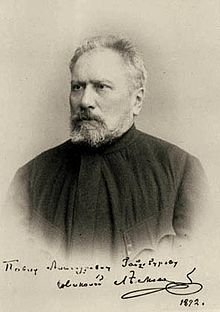The sealed angel
The sealed angel ( Russian Запечатленный ангел , Sapetschatlenny angel ) is a short story by the Russian writer Nikolai Leskow , which appeared in 1873 in issue 1 of the Moscow magazine Russki Westnik .
prehistory
The first-person narrator Mark Alexandrow, an orphaned mason who was still young at the time, built a chain bridge over the Dnieper in the Ukraine with a group of like-minded migrant workers, all of whom came from far away Russian regions, for the fourth year now. Mainly because of their old-faith religious affiliation, this group under their guild master Luka Kirilow had endured so long under the English construction manager James. Because such Raskolniken were persecuted in Russia around 1850, but those builders had not been bothered by the Russian state in the last three years. It should stay that way if possible. Therefore, these builders practiced their religion in secret and observed secrecy.
content

John the Baptist (desert angel) with the Christ child lying in the chalice .
The vain accounting officer Pimen Ivanov, a boastful and busybody from the ranks of the builders, draws the authorities' attention to the state-banned worship of the Old Believers through thoughtless remarks. Uniformed officials, gendarmes and soldiers surprise the seventy-year-old grandfather Maroi in prayer in the tabernacle . The Old Believers do not succeed in saving their holiest, the two hundred year old angel icon from the workshop of a Stroganov master, from being attacked by the armed men . One of the officers presses the boiling resin of his sealing wax stick onto the angel's face. The builders' guardian angel, blinded in this way, is confiscated and given to the archbishop for safekeeping in the big city on the other bank of the Dnieper.
Pimen leaves the Old Believers and joins the state church. The construction manager James wants to get the icon back from the builders, but only gets the frame of the icon from the archbishop. The narrator Mark Alexandrow sets out on behalf of his compatriot Luka Kirilow and brings the icon painter Sebastian over. Around Christmas time, Grandfather Maroi, Luka Kirilow and the narrator Mark row across the Dnepr to the Archbishop and steal the icon from him. The saint picture painter Sebastian unseals the angel with a glowing iron and copies the restored work of art. When the artificially aged copy was supposed to be pushed to the archbishop, the onset of ice on the river made it impossible to cross it in a boat. Only the pillars stand from the chain bridge. The chains are already hanging on it. Luka Kirilov accomplishes the feat. In the winter storm, the guild master balances over the chains to the other bank and confesses his theft to the archbishop. His Eminence forgives.
Leskow presents a happy ending: the next morning the Old Believers join the state church. The end of the story - the conversion of the Old Believers - was forced on Leskow by Katkow (the reactionary, conservative editor of the magazine Ruskij Westnik).
reception
- Dostoyevsky praised the text in a writer's diary , but criticized "the rapid conversion of the Raskolniki to the state church" as implausible.
- 1969: Reissner writes: “The story comes to life mainly because it is told by an old believer. In this way the unshakable conviction of the miraculous power of a holy image becomes understandable. "
- 1985: Dieckmann thinks that Leskow understood icon painting not only as the maintenance of the traditional, but as a contribution of the Old Believers to a Russian art tradition that has remained alive.
German-language editions
- The sealed angel. German by Ruth Fritze-Hanschmann . P. 7–100 in Nikolai S. Leskow: At the end of the world and other master stories. 391 pages. Dieterich'sche Verlagsbuchhandlung, Leipzig 1968 (2nd edition)
- The sealed angel. German by Hartmut Herboth. P. 5–84 in Eberhard Reissner (Ed.): Nikolai Leskow: Collected works in individual volumes. The enchanted pilgrim. 771 pages. Rütten & Loening, Berlin 1969 (1st edition)
- The sealed angel. German by Hartmut Herboth. P. 450–525 in Eberhard Dieckmann (Ed.): Nikolai Leskow: Collected works in individual volumes. Vol. 3. The sealed angel. Stories and a novel. 795 pages. Rütten & Loening, Berlin 1985 (1st edition)
Output used:
- The sealed angel. Translated from the Russian by Ruth Fritze-Hanschmann. Illustrations by Kurt Eichler . 120 pages. Union Verlag, Berlin 1972 (1st edition, licensor: Dieterich'sche Verlagsbuchhandlung Leipzig)
Web links
- The text
- Entry in the Laboratory of Fantastics (Russian)
- Entries in WorldCat
Remarks
- ↑ Leskow means the construction of the Kiev Chain Bridge in the years 1848-1853.
- ↑ The Russians say Jakow Jakowlewitsch to the Englishman.
- ↑ According to the above, the big city is Kiev.
